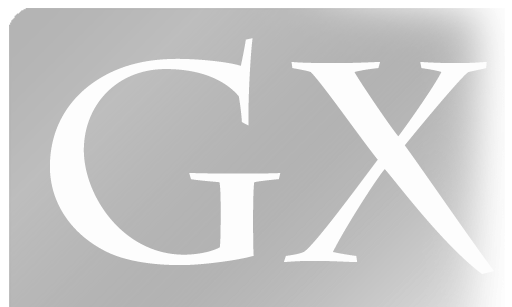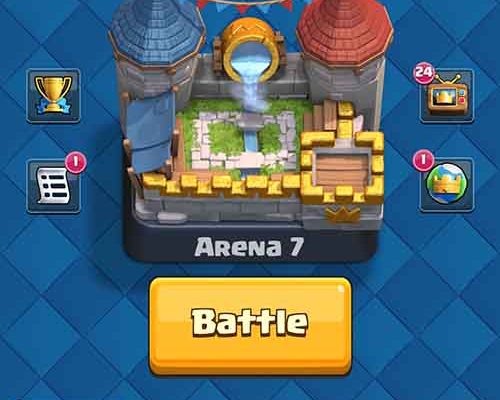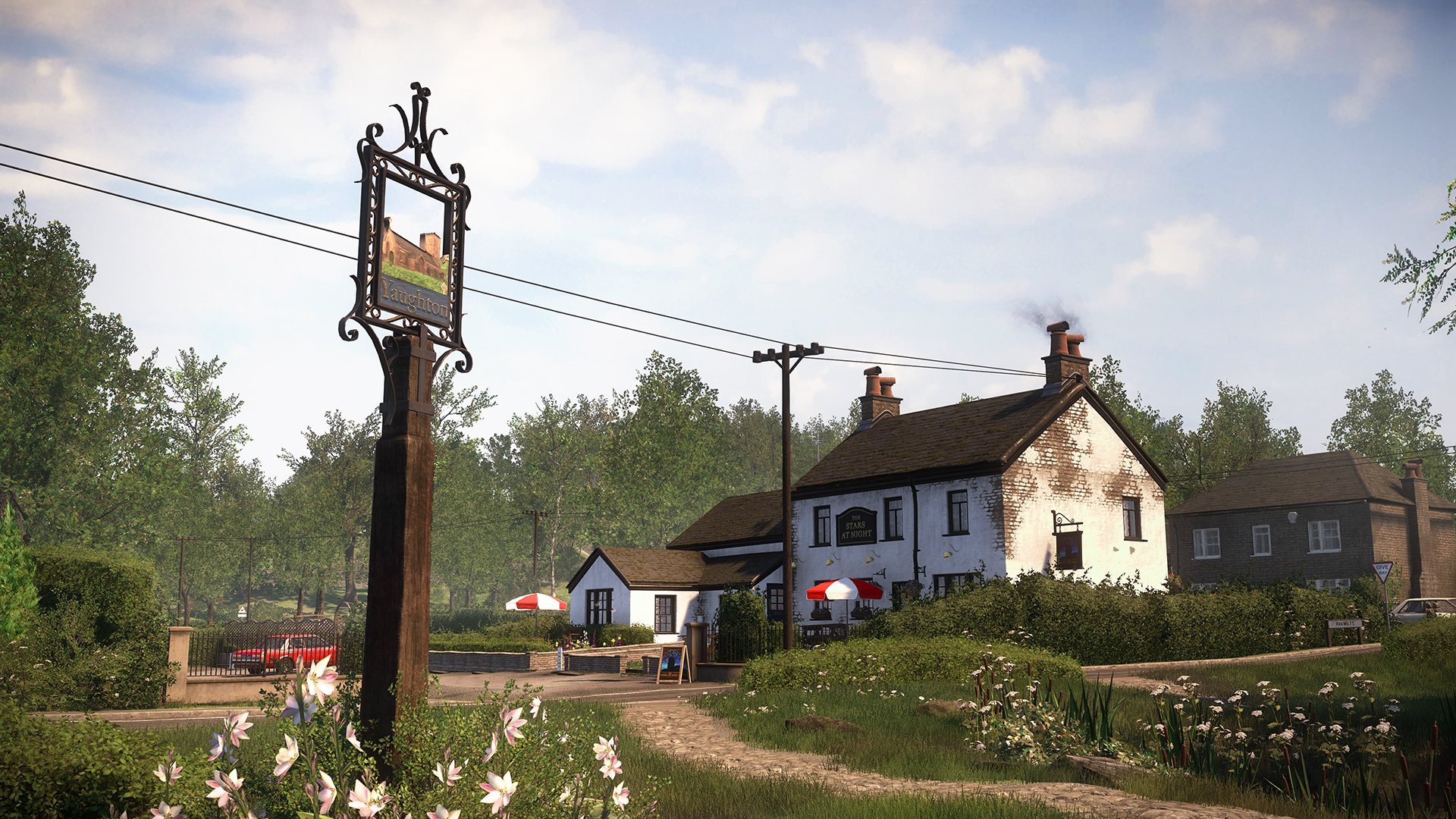Writing this on 31st December 2016, it is time to review this year. Here, I describe games that our family played in 2016 – regardless of when they were launched.
Let’s start by taking a snapshot of today. Right now, on a typical Saturday evening, three games are being played around me. Today, they happen to be Fallout 4, Geometry Dash and Best Fiends. Of our family’s five members, there are active three gamers: daughter, son and me.
What have we played in our living room since January 2016? I first name a few games that I still remember, then I dive deeper into a few of them.
- Witness.
- No Man’s Sky.
- Mortal Kombat X.
- Mirror’s Edge: Catalyst.
- Metal Gear Solid V: The Phantom Pain.
- GTA V.
- Uncharted 4: A Thief’s End.
- Everybody’s Gone to the Rapture.
- Minecraft (several versions of it).
- Clash of Clans.
- Boom Beach.
- Hay Day.
- Clash Royale.
- Best Fiends.
- Best Fiends Forever.
- 100 Balls.
- 8 Ball Pool.
- Agario.
- Alien Apartment.
- Angry Birds 2.
- Angry Birds Star Wars.
- Archery Master.
- Avicii – Gravity.
- Badland and Badland 2.
- Blendoku 2.
- Block! Hexa Puzzle.
- Hexa Blast.
- Contre Jour.
- Crossy VR.
- Follow The Line.
- Omar Sharif Bridge.
- Roll the Ball.
- Rolling Sky.
- Run Bird Run.
- Scrubby Dubby.
- Tetris.
- Vikings.
- VR Pac-Man.
- VR Roller Coaster.
- Weldee.
And Pokémon Go – I almost forgot!
 Forgetting Pokémon Go is a revealing memory slip: the hit game released in July 2016 vanished in a few months. I enjoyed the game until level 21 – then the progress somehow just stopped. I played Pokémon Go actively in July-August 2016, and it triggered me to use also Ingress. Ingress is the older location based game that gave Niantic the platform on which they built Pokémon Go. I used Ingress’ navigation to find PokéStops of Pokémon Go.
Forgetting Pokémon Go is a revealing memory slip: the hit game released in July 2016 vanished in a few months. I enjoyed the game until level 21 – then the progress somehow just stopped. I played Pokémon Go actively in July-August 2016, and it triggered me to use also Ingress. Ingress is the older location based game that gave Niantic the platform on which they built Pokémon Go. I used Ingress’ navigation to find PokéStops of Pokémon Go.
From professional viewpoint, Pokémon Go was an exceptional game in many ways. The business concept was great: a strong and loved brand combined with location based interaction that had already been tested to work well. To fail with these starting points, you must sabotage the project. And somebody did. The game was not even on beta level when it was launched. In the interaction design, there were too many amateur level mistakes. The code was full of bugs. The servers did not work properly during the first weeks. And so on, we all know the story.
It would be interesting to redesign Pokémon Go, applying all the wisdoms of Nir Eyal’s book “Hooked – How to Build Habit-Forming Products” and fixing also all of the interaction design flaws that the game has. But sorry, now I am slipping off the topic.
Let’s continue by highlighting the favourite games of each family member. I’ll start with PlayStation games, then move to mobile and computer games.
Our biggest favourites in 2016
I start by asking for the daughter’s favourite? “Fallout 4”, she says. Fallout 4 is an apocalyptic action RPG. What makes Fallout 4 better than for example Metal Gear Solid 5? Her arguments are clear: “There are so many choices in Fallout, and the game becomes always different. You decide the big goals yourself. In Metal Gear Solid you pick up missions where the goals are given – then you only make decisions on the ways how to achieve it.” So what is
Fallout 4

Fallout 4 was released about a year ago, in November 2015 (link to trailer). The protagonist has survived a nuclear war thanks to a fallout shelter and emerges 200 years later to find a post-apocalyptic world.
Fallout is not only about exploring the world and finding the right tools and weapons. In this game, also the dialogs are critical – how should I behave, whom should I trust, whom should I help. In other words, your own values guide the plot. Within each dialog, there are numerous options to proceed, and no matter what you choose, the voice acting is excellent and the plot continues naturally. The dialogs are tight and well-written, and for us who speak English as the fourth language, the English subtitles make sure you don’t miss anything.
Fallout has also minecraftian elements. You collect resources, then you can build this and that. And what you build where, that you choose freely. Should I craft some beds so these people can rest? Or build a radio beacon to invite more people? If yes, then I need to build also a generator for it.
Things get even more complicated as you make promises to different factions throughout the wasteland. If you try to play friends with all, you eventually find yourself in positions where your loyalties start to conflict.
So right now, on my left, my daughter is playing Fallout 4 on PS4. She’s on level 31, after two weeks of playing. I admire that. While I write this, she just entered the Crater of Atom. That’s a nasty place: radioactive wasteland where only Deathclaws and Radscorpions remain alive.
Then myself: what was my own favourite game in 2016?
The Witness
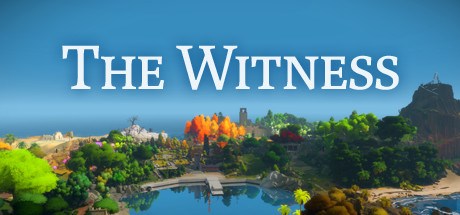 The Witness is a puzzle solving game released in January 2016 for PS4 (available also for Xbox One since September 2016, iOS promised for 2017).
The Witness is a puzzle solving game released in January 2016 for PS4 (available also for Xbox One since September 2016, iOS promised for 2017).
If you liked Myst, you love The Witness. And I loved Myst when I played it twenty years ago.
The puzzles of the Witness are based on interactions with mazes presented on panels or hidden within the environment. The player will have to determine the rules of each puzzle from visual clues and audio recordings scattered around the island.
You move freely around the island and solve an unknown number of enjoyably challenging problems, proceeding from easy visual puzzles to multi-sensor cryptic challenges, but that’s not the point. Just like in Myst, the purpose of The Witness is to understand its purpose. And to understand it, playing Witness might not be enough. On an audiolog that you might find on the island, recorded in 1975, you hear astronaut Russell Schweickart proposing that we all should take a space flight and see the Earth from the space – to understand.
The Witness was designed by Jonathan Blow. Jonathan told in an interview (in which “…the creator talks about his fiendishly difficult new game”) that an average player would solve the 650 puzzles of the island in 80 hours. In our family, our daughter solved all of them in two weeks. We others will be playing The Witness also in 2017.
Mirror’s Edge: Catalyst
 Difficult too but in a totally different way was Mirror’s Edge: Catalyst, an first-person action-adventure where you move through a futuristic city using parkour movements.
Difficult too but in a totally different way was Mirror’s Edge: Catalyst, an first-person action-adventure where you move through a futuristic city using parkour movements.
The game was released in June 2016, and I got it as a present from a good friend who thought our children would like it. Yes they did, and so did I. The difference was that the children learned fluently all the parkour tricks while I hardly survived the tutorial.
Just like in Fallout, Minecraft and Witness, also in Catalyst’s world you can roam freely and you can complete the tasks in different ways – and that’s literally, you need to master the ways through the city. In other words, if you have played the previous Mirror’s Edge where things were linear, this one’s different.
Everybody’s Gone To The Rapture
Continuing with open world experiences with no linear plot, an extreme approach was taken in Everybody’s Gone To The Rapture, released in April 2016. My daughter read somewhere about its unusual idea, it sounded fascinating, and it was.
In this game you find yourself in an empty village, somewhere in England in 1980s. You just walk around. No tasks, no interaction with anyone or anything. Your task is to understand what happened to all those people who lived here. Every here and there you can sense their past presence: hear their voices. And that’s all. A wonderful experience for those of us who are tired of action games.
 Metal Gear Solid V: The Phantom Pain
Metal Gear Solid V: The Phantom Pain
Metal Gear Solid V: The Phantom Pain was released in September 2015, and we started playing it in December 2015.
The story follows the mercenary leader Venom Snake into Soviet-occupied Kabul province and the Angola-Zaire border region. Carrying your binoculars, maps, pistols, assault rifles and explosives, you should sneak undetected, kill the guards, free the prisoners, and get out alive. Usually you don’t. You end up shooting and running and thus dying.
Many were the nights when our whole family gathered in front of the TV to follow the the story and to propose the best tactics for the one who was holding the control.
For me, Metal Gear Solid V is still a learning challenge, to be continued in 2017.
Uncharted 4: A Thief’s End
Uncharted 4: A Thief’s End (released in March 2016) we all liked, including my wife who does not play games herself. This is an action-adventure game played from a third-person perspective. The protagonist Nathan Drake is hunting a long-lost treasure with which he could save his brother. Whenever one of us was playing this, other family members gathered around to watch the game as an adventure movie. Having strong family values myself, I appreciated the storyline where the husband Nathan and her wife Elena solve the challenges together.

No Man’s Sky
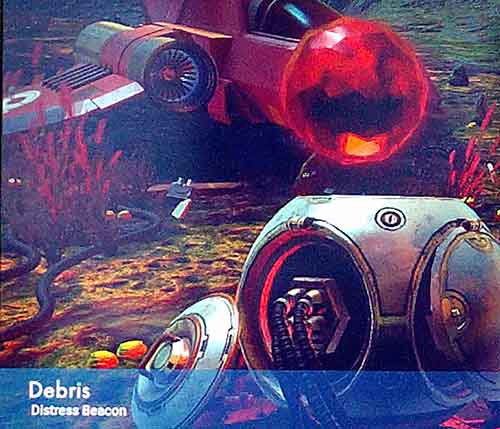 And then the biggest game of 2016, namely the one with 18×1018 planets: No Man’s Sky.
And then the biggest game of 2016, namely the one with 18×1018 planets: No Man’s Sky.
Having had astronomy and cosmology as my hobbies already for some decades, I naturally downloaded NMS on its launch day on August 10, 2016.
The game is beautiful, and it provides the endless pieceful exploration that I like. No Man’s Sky felt great at the beginning, and also other members of the family played it on three different accounts for a couple of weeks. Then, for some reason, each of us just abandoned it. For some reason the game did not motivate us enough – none of us. Why? Perhaps the worlds of the universe are too similar. But beautiful this game is, and I would recommend anyone to at least try it.
 Assassin’s Creed: Syndicate
Assassin’s Creed: Syndicate
On the last week of 2016, we started Assassin’s Creed Syndicate, the ninth part of the Assassin’s Creed game series. Each game is placed in a different historical context, following the centuries-old struggle between the Assassins, who fight for peace with free will, and the Templars, who desire peace through control.
In the Syndicate, you are placed London in 1868 witnessing the outcomes of the industrial revolution. I value the possibility to roam freely in a real historical city. I believe we will spend many days with Assassin’s Creed Syndicate also in 2017.
Targeted for someone else
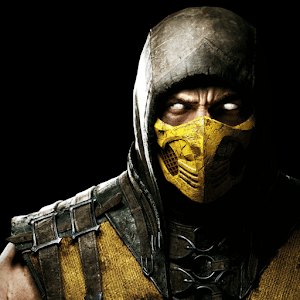 Mortal Kombat X
Mortal Kombat X
There was one game that nobody in our family liked: Mortal Kombat X.
Mortal Kombat was about hitting opponents and killing them in brutal ways. The visual emphasis was in blood and ripping off limbs. There was no proper storyline.
And consequently, nobody in our family continued to play Mortal Kombat after trying it a few times. Sneaking in Metal Gear Solid or just piecefully walking in The Witness or in Everybody’s Gone To The Rapture attracted each of us so much more.
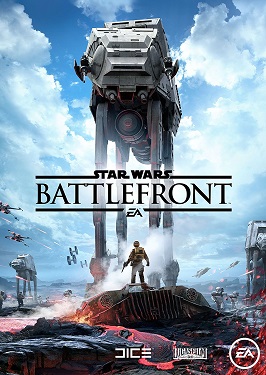 Star Wars: Battlefront
Star Wars: Battlefront
After Christmas, we played some starter episodes of Star Wars: Battlefront. It is an action shooter game. You either run and shoot, or fly and shoot.
In the Battlefront, there is no big story, just a collection of battles to complete. And no, we did not get hooked on that.
(P.S. We did return to Star Wars: Battlefront again in January 2017, and learning it better, it started to attract.)
Mobile games
In our family we have for individual reasons each selected an Android phone. From gaming perspective this is great as we can share the game experiences. During 2016, we played all too many games to be described in one post. I focus on those that were favourites of each family member.
Let’s start with my son’s favourite:
Geometry Dash
In Geometry Dash, you jump and fly your way through a stream of obstacles by tapping the screen. Sounds easy? It isn’t. Above the easy starter levels, the difficulty grows beyond insane. The obstacles appear so fast that you have no reaction time: you have to practice all your actions in advance and learn the right rhythm. Each level has a distinctive background music. Listening to the beat supports you in placing your taps to the right milliseconds.
In Geometry Dash, you typically start by playing through the officially released levels, then proceed to the levels published by other players, and finally you start to design and publish your own levels. Players rate each other’s levels by voting: Easy – Normal – Hard – Harder – Insane – Demon.
Today, my son is practising the Deadlocked. This is how it looks like – and yes, it is rated as Demon:
Looking at my own mobile year, I continued playing Clash of Clans and Boom Beach also in 2016.
Clash of Clans
In Clash of Clans, I am on level 91. Having played the game for two years, the game still attracts me. I started playing it together with my son. In our first Clan, there were also three other family teams where the fathers were playing CoC together with their daughters or sons.
Now I am representing our family alone in our clan. I do no more participate in wars – I typically just donate troops to other clan members. What keeps me opening the app? Perhaps it is the idea that even I don’t seek for any progress for myself, I can effectively help others.
As you can see below, I have placed my Town Hall outside the walls to attract attackers. It is protected by two hidden Tesla towers and a Freeze Trap, the novelty of this Christmas season. Focusing a heavy attack on the Town Hall, one can pretty easily get one star. Getting two stars is much harder – and not a single attacker has got three stars of my village over the past year.
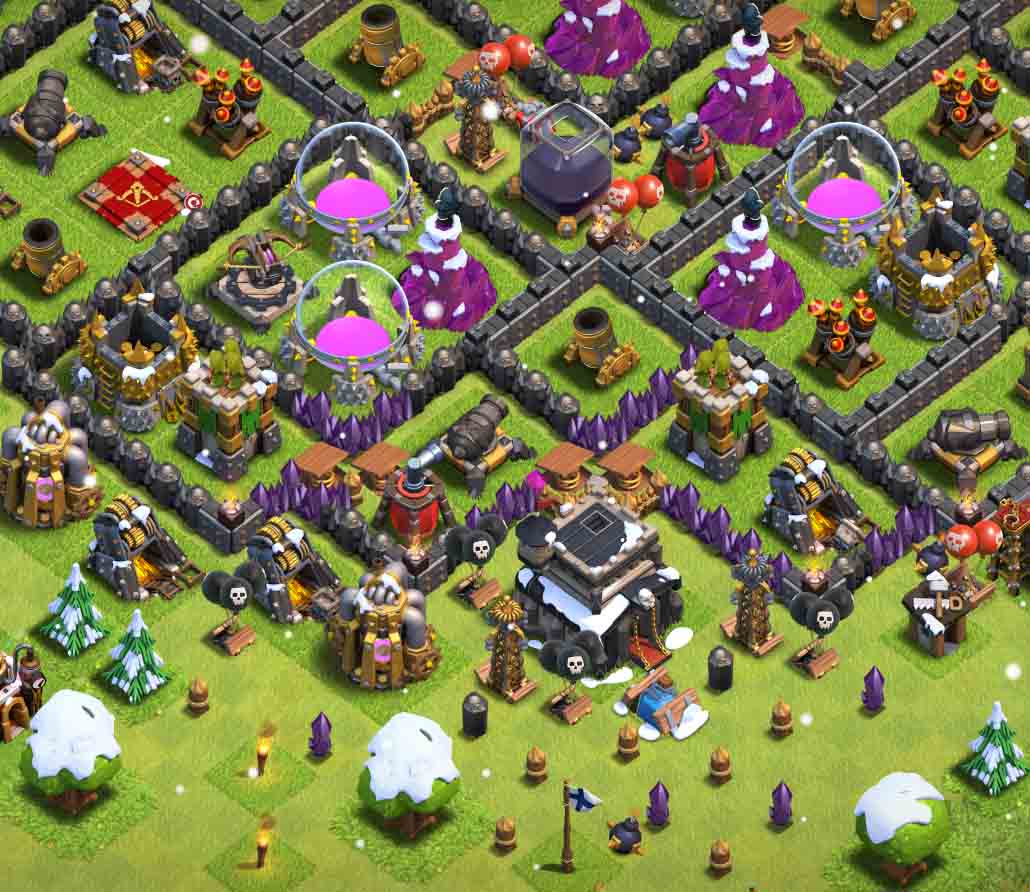
Boom Beach
In Boom Beach, I continue on level 50. In 2014 when I started to play Boom Beach, my first reaction was “This is boring, I won’t play this for more than a few weeks.” But still also in December 2016 I attack Dr. Terror’s bases, I defend my base against Lt. Hammerman, and I upgrade my defenses every other day. The game feels attractive after two years of playing. What’s the secret? The Supercell guys have read their Nir Eyal.
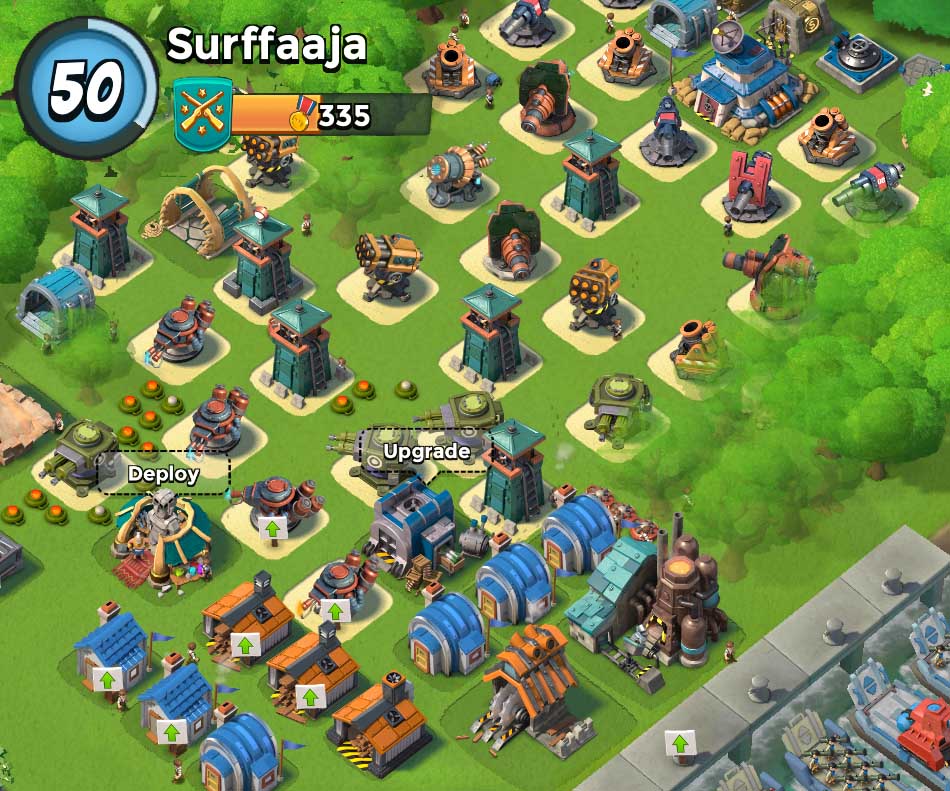
Clash Royale
As my third regular Supercell experience, I play Clash Royale. Clash Royale was launched in March 2016. At first sight I was impressed of the simplicity and clarity of the interaction. To analyse it in detail, I created a map of it.

(If you want to see the details in 1:1 size, I published the full size picture at clashroyale.wikia.com/wiki/File:Clash_Royale_Navigation_4700px.jpg )
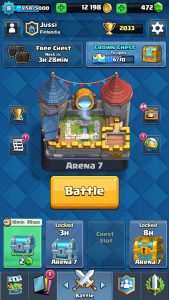 At first, I thought that this is not a game for me. I have not before liked card collection games. Over the year, I learned to like Clash Royale more and more. This is a very rare game where my frequency of playing has continued increasing from month to month.
At first, I thought that this is not a game for me. I have not before liked card collection games. Over the year, I learned to like Clash Royale more and more. This is a very rare game where my frequency of playing has continued increasing from month to month.
I like that there is a very natural limit that ensures you don’t play this too much. As soon as you have enough chests for a day, there’s no point in playing more.
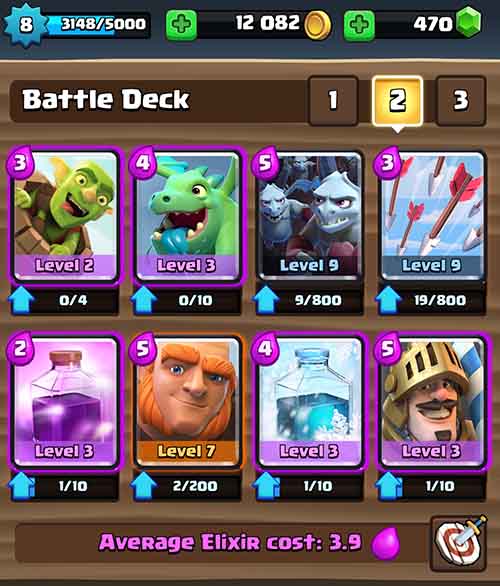 With this battle deck (on the right) I have been happy from Arena 4 to Arena 7. Along the way, I have tried many interesting cards – but the simplicity of this deck has always attracted me back.
With this battle deck (on the right) I have been happy from Arena 4 to Arena 7. Along the way, I have tried many interesting cards – but the simplicity of this deck has always attracted me back.
I usually start a battle with a Giant, followed by either Prince or Baby Dragon. If I don’t get a Giant, then I wait for the opponent’s troops and destroy them with a Horde of Minions or Arrows. If and when my troops proceed to hit a Tower, I boost them with the Rage spell.
 Best Fiends
Best Fiends
The Best Fiends (by Seriously) continued as one of my favourite wastes of time also in 2016.
This type of puzzle game fits in my rhythm of days. I can start a new level, play for some minutes, interrupt, a continue with the remaining moves a few hours later.
The basic idea of Best Fiends is similar to many other match-the-similar-objects games. At each level, you’ll have a set number of moves in which to meet the stage’s requirements. The difference is that here the details – speaking of both the visual and the interaction design – have been designed close to perfection.
So far each and every level has been more difficult than the previous ones. And astonishingly, despite the randomness of the starting positions and my variations in trying different tactics, when I get to the last move I am always almost at the goal – but only almost.  Getting so close, knowing that getting through might have required only a tiny change in what I did, that feeling makes Best Fiends feel so good.
Getting so close, knowing that getting through might have required only a tiny change in what I did, that feeling makes Best Fiends feel so good.
I am now on level 145, i.e. in the very beginning. I still have hundreds of levels left for 2017.
And what else?
Having liked Best Fiends, I naturally also installed Best Fiends Forever. The first time I played it uninterrupted for 15 minutes. The experience was monotone. I never opened the game again. This is a true clicker game: keep on tapping as long as you have power in your battery. In my eyes, the brand of Seriously – and Best Fiends especially – associates to mind-triggering puzzles, and this game does not fit in the picture.
100 Balls has very simple rules. Tap the pot to fill the moving cups with falling balls. Filled cups will return balls to the pot. The game ends when all balls are lost. Games like these do attract me, and I might keep on playing them again and again repeatedly. But the game is not hooking: the next day you don’t remember any reason to re-open so you choose another game.
 8 Ball Pool is a pool game in which you play against real human opponents, either in Tournament mode or 1-on-1, either with your friends or random opponents.
8 Ball Pool is a pool game in which you play against real human opponents, either in Tournament mode or 1-on-1, either with your friends or random opponents.
The multiplayer functionality has been designed exemplary well – and the same multiplayer concept is used also in many other mobile games published by Miniclip, e.g. Soccer Stars and Archery King.
 Agario was launched for Android already in late 2015 but we started playing it first in spring 2016. This game is a refreshingly different – simple and unique, designed by Matheus Valadares. Your goal is to grow as big as possible by swallowing smaller bubbles without being swallowed yourself by bigger ones. Agario is really a multiplayer game: each of the dozens of bubbles around you is controlled by a different player.
Agario was launched for Android already in late 2015 but we started playing it first in spring 2016. This game is a refreshingly different – simple and unique, designed by Matheus Valadares. Your goal is to grow as big as possible by swallowing smaller bubbles without being swallowed yourself by bigger ones. Agario is really a multiplayer game: each of the dozens of bubbles around you is controlled by a different player.
Badland, developed by Frogmind, was originally published already in 2013. The publishing of Badland 2 (Dec 2015 for iOS, 2016 for Android) brought it back to global awareness. The game is beautiful, both visually and musically.
If you like Badland (and you do, of course), then you like also Contre Jour, designed by Maksym Hryniv. The game starts with an alert “Use headphones for the best audio experience.” Even with regular speakers, it sounds good. Before the Frogmind designers created Badland, I believe also they have enjoyed Contre Jour.
When I open Contre Jour, I do that not for playing but for relaxing and enjoying the atmosphere. Originally a browser game, Contre Jour pushed the boundaries what was thought to be possible with just HTML5 and JavaScript. In reviews, Contre Jour was described as a pioneer in blurring the lines between interactive art and games.
Contre Jour has only one weakness: it is not free. Paying a small price before you can try it out is perhaps why this game has still only 100.000 downloads in Google Play. With another price model, this piece of art would surely be a favourite of millions of people.
PC/Mac games
Compared to previous years, we played much less on our laptops this year. In the first decade of the millennium, we often played browser games. Coming to 2010s, we shifted from computers to tablets. From browser games we moved to downloads from App Store or Google Play. And now, over the last year, both our laptops and tablets often stay unopened on the floor from evening to evening. Except when you need to play Minecraft or Terraria.
Minecraft

The Minecraft platform is old but the games built on it renew every year. Also during 2016, especially our son has enjoyed Minecraft in its different forms, including Story Mode, Minecraft Games, Minecraft Minigames, and naturally also by just building new worlds.
For multi-player battles in Minecraft, he teams up with his friends using Skype calls to coordinate their actions. Occasionally, just for his own fun, he creates complex machines using Redstone blocks and Command blocks. Or develops a Minecraft game for others to play, using for example a platform provided by Hypixel. He publishes a YouTube channel on Minecraft, and thanks to watching others’ Minecraft videos and chatting on Minecraft servers, his English has become very fluent. I thank Markus “Notch” Persson for having created this endless platform of creativity and learning.
Terraria
Terraria is already an old game (Windows in 2011, OS X in 2015) of which I learned first in spring 2016 when an industrial designer colleague told me he has starting playing a “2D equivalent of Minecraft”. At home, we have only one Terraria expert: my son. I better just quote hime. So, “why do you play Terraria?”
And he answers: “Sorry dad, that is a really long story, and I’m now busy drawing pictures.” So we’ll come back to this topic next year.
What did we not play in 2016?
In 2016 we seem to have stopped playing some games that we used to play a lot in earlier years. We do no more play web games: We have left behind all those wonderful small games of Miniclip. Likewise we do no more play the Grow games of Eyezmaze – really great puzzles that challenge both your logic and your memory.
Still in 2015, our Wii was in very regular use. Wii Sports, Xenoblade Chronicles,… Now we haven’t opened the Wii for a long time for anything but starting Netflix.
Supercell’s Hay Day is principally quite similar to my favourite games Clash of Clans and Boom Beach. However, there’s something critically different. Although I did my best to play also Hay Day regularly, I got tired of it. I just gave it up at level 36.
Perhaps Hay Day was too much based on forming socially active teams.
In addition to the above, we played a few dozen interesting games which however did not make their way to the top of our family ranking list.
Looking for 2017, I am waiting for Big Bang Legends, and the whole growing wave of Finnish serious gaming. Lightneer Inc launched Big Bang Legends for Slush but their softlaunch was only on iPhone. Our family continues waiting for their Android launch.
